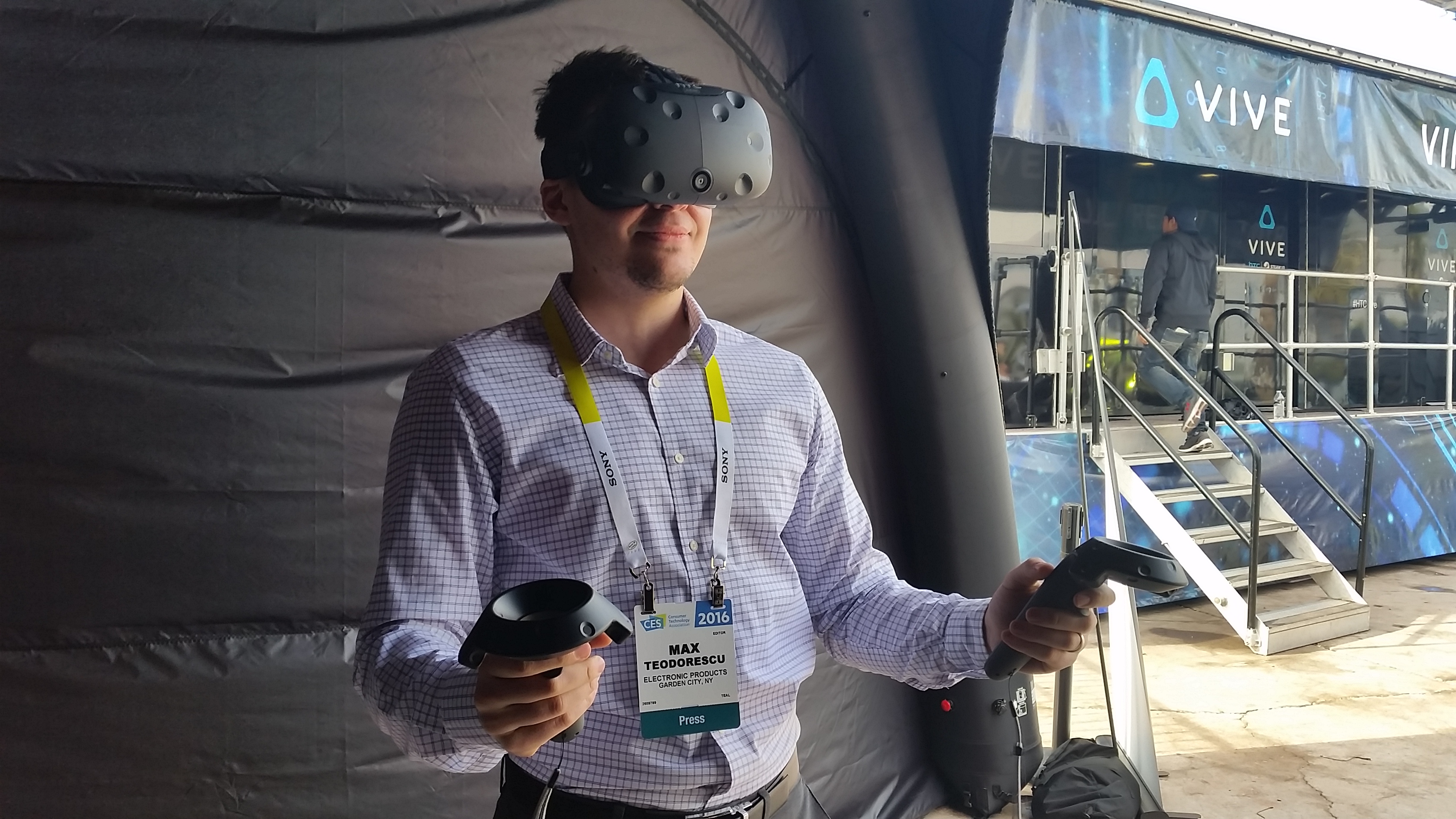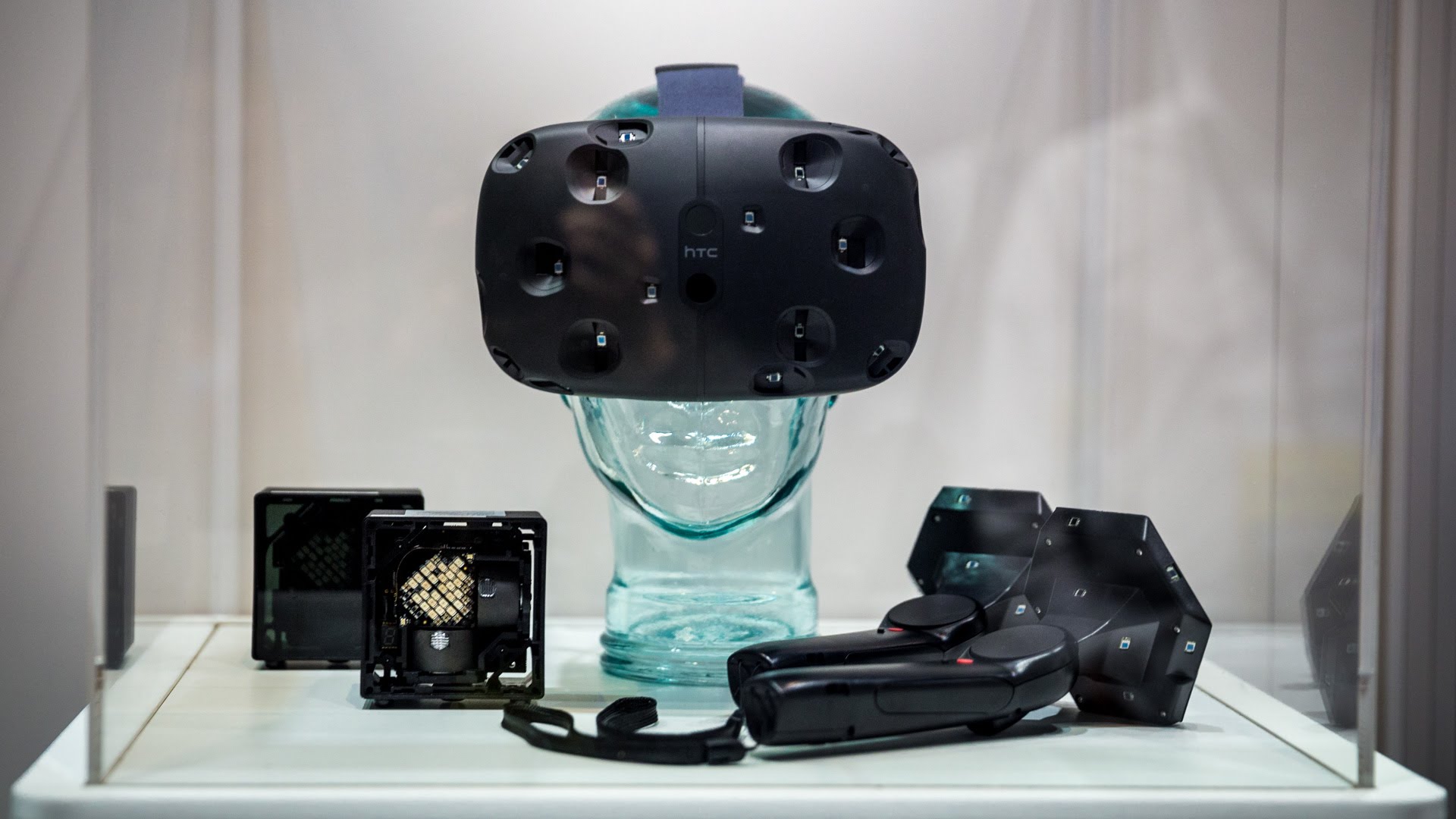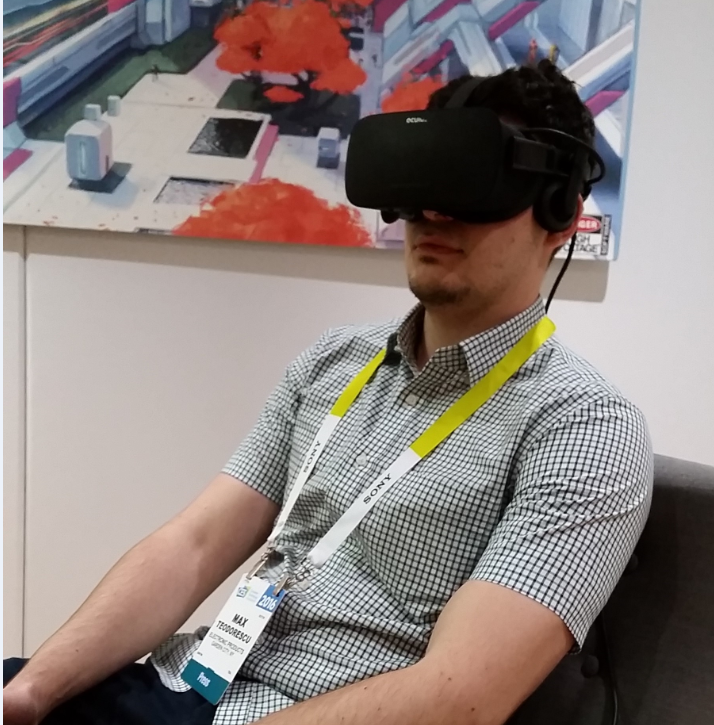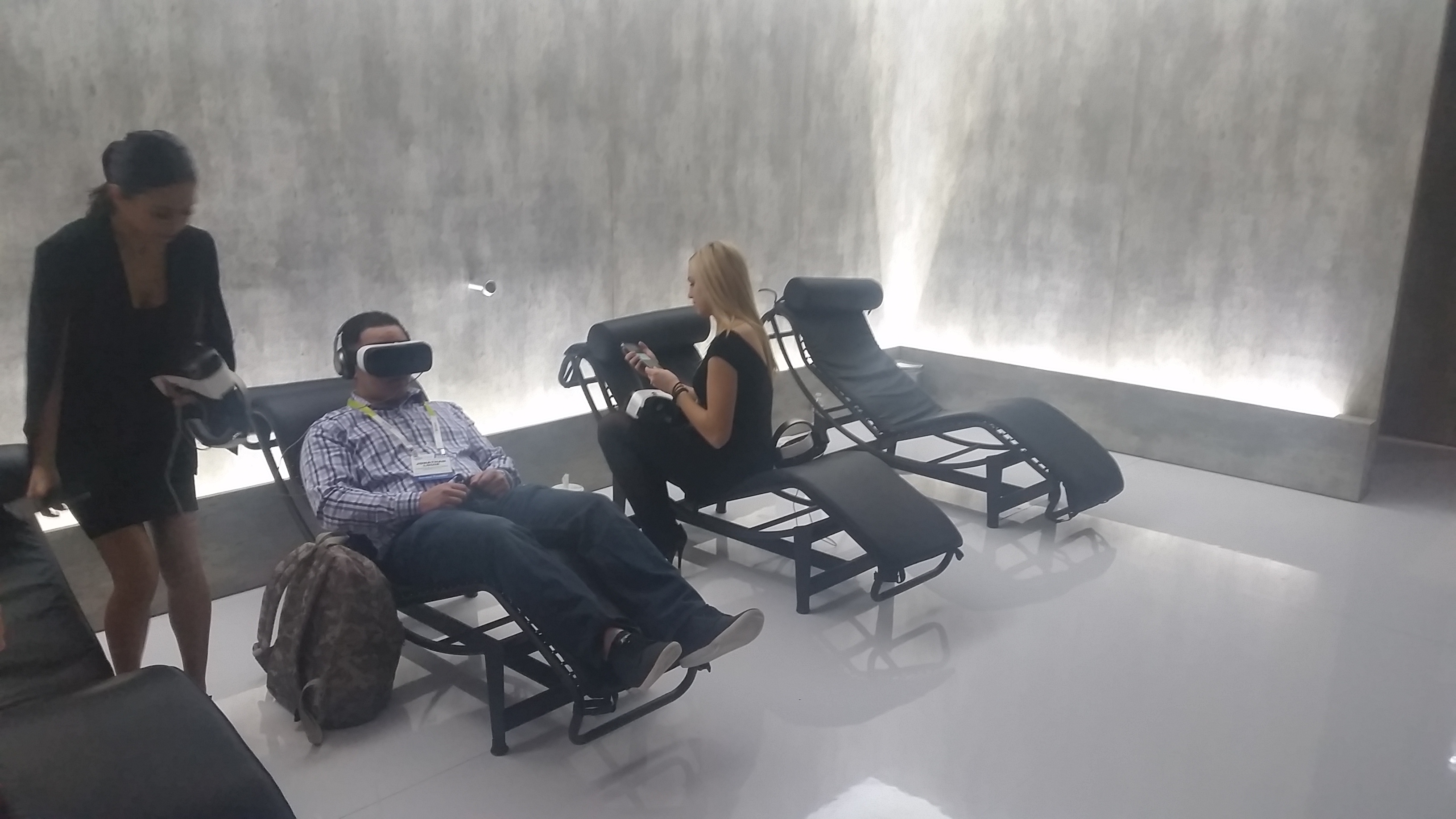
One of my main objectives during CES 2016 was to get my hands on and test out the Oculus Rift and HTC Vive to see what this virtual reality thing is all about. When it comes to VR there are two types of people: the utterly mind-blown or the skeptics who think we've still got ways to go. I have to admit, until dawning on a pair for myself, I was in latter camp. After testing out both pairs—along with the inferior but capable Samsung Gear VR—I'm ready to sing my praises. Absolutely nothing you've ever experienced compares to contemporary VR. This is no hyperbole; you'll only understand if you test it out for yourself.
A healthy level of skepticism makes complete sense given VR's shaky history, popping up every few decades, but never being capable enough to catch on and escape being labeled as a gimmick. This generation of hardware, however, permits high-resolution stereoscopic 3D graphics within a field of view that encompasses every square inch of your vision, thereby creating a very real sensation of being in another time and place.
Graphic capability is scaleable, as the headsets are powered by external PCs that require relatively beefy hardware—meaning there's a certain amount of future-proofing built right into the headsets so long as the internal screens stay relevant. As a hardcore gamer and PC building-enthusiast, I'm arguably in upper-echelon of skeptics, but after experiencing VR for myself, I felt like a child all over again. It's not simply immersive, it's an alternative reality.
HTC Vive
Over the course of two days at CES, I waited, crouched, and sat in long queues, patiently wading my way through all the major VR exhibits, from the engrossing HTC Vive to the humble yet capable Samsung Gear VR. And with every piece of hardware I got my hands on, my excitement only compounded. I traveled through an underwater ship-wreck, I floated as a disembodied presence behind an arctic explorer in a Lovecraftian nightmare, and I even rode a Faraday.
Compared to consuming content on a screen, stepping into VR feels like sticking your head out of a window and realizing a whole other world exists outside of box-shaped perimeter surrounding the window. The image conforms to your field-of-view, so there are absolutely no borders surrounding anything you see, and all the content you do see, pops out in stereoscopic 3D. Three-axis head-tracking and three-axis position-tracking are integral to birthing the illusion of presence in the virtual space, making your head the pivot on which the camera resides. This allows your “point of view” to shift as you turn your head— a very different experience than controlling the camera with a mouse or joystick, as the case in most videogames.

The HTC Vive raised this experience to a new level with its “lighthouse” base station, a series of photosensors that map out a 15 by 15 foot tracking spacing, so that any movement within this proximity is registered as movement in the virtual world. With this feature, the room you're standing in becomes a part of the virtual experience. In my case, that “room” was a tent outside the Las Vegas Convention Center where HTC was demoing the headset, but the virtual space I occupied was an underwater ship-wreck.
I can't describe in words how awing of an experience this was. Because my movement in the tent translated to movement on the ship's deck, my brain was instantly fooled into thinking I was really there! Turning to my right I saw debris hanging off the starboard bow, while turning to my left revealed a deep chasm into the sea floor, which I was able to look down toward by peering over the ship's decayed railing. Above me, a massive sperm whale swam past, kicking its tail in my direction and made my body reflexively take a step back. At this point I knew; contemporary VR hardware finally reached that special threshold where it can evoke a natural suspense of disbelief in its wearer without the slightest effort. The uphill struggle is over and from here on end it will only improve.
The next demo transported me into a cartoony-looking office, resembling the 90's computer graphics from music video of Dire Strait's Money for Nothing . Job Simulator , as it was ironically called, was an amusing sandbox for showcasing the Vive's interactive controllers. In the game, the controllers appeared as massive Mickey Mouse hands that are given free rein to touch, throw, or screw around with any object in my cubicle. Surprisingly, my brain had no issue interpreting these controllers as actual hands, and I found the process of picking up and tossing items across the cube very realistic.
Although impressive, the sensors occasionally lost track of the controllers, causing them to fly uncontrollable in virtual space until reset by the exhibition demonstrator. Not a big deal, but it was a reminder that the Vive remains a work-in-progress. Also—a bit of tactile feedback would've gone a long way in improving the experience.
Oculus Rift
After another two hour wait the following day, it was time finally to try the headset that started it all—the Oculus Rift. For starters, the Rift and the Vive are very similar headsets. Both feature a combined 2160×1200 (1080 x 1200 per eye) resolution per OLED screen with a 90 Hz refresh rate, a 110 degree FOV, and lightweight hardware. But unlike the HTC Vive's use of light sensors to create virtual space around the wearer, the Oculus is meant to be enjoyed as a seated experienced.

Knowing this in advanced, I expected an inferior experience with the Oculus. What actually occurred was nearly the opposite. Powering on the headset revealed an interface littered with multiple titles that I was given seven minutes to test. I selected a game titled Edge of Nowhere and began my journey as a wayward explorer in an arctic wasteland.
Going in blind, I didn't realize the game featured a third-person perspective attached to fixed point, pivoted behind the player-character. This was unlike anything I previously encountered in VR, and inspired the sensation of floating as a disembodied presence beside the character, sharing in his horror. It's such an immersive experience because the VR's massive field-of-view and 360 degree head-tracking places the player within the game they're playing.
In one instance, when I guided the explorer down rope into a cavern, an omnious roar was heard from beneath our position. I looked below and saw a dark figure scampering from the depths. A new sound joined in the cacophony, this one from above. My head instantly shot up to scan for its origin, all the while the camera's pivoted position followed the character down the rope, but VR headset allowed me to look around from this position. At this point I was three-and-a-half minutes into the seven minute trial, but the excitement was so great that I continued playing this single title for the remainder of my time.
By the end, I was a officially converted and ready to pre-order my own headset. Oculus taught me that you don't need a fancy peripherals to enjoy VR. A standard control pad will suffice, because it's all about the FoV and head-tracking. Modern graphics will fuel the imagination, while third party support will propel the product's life cycle. Vive's lightbase station sure is nice, but it's a bonus.
Samsung Gear VR
The last headset I tested was Samsung's Gear VR, an affordable $99 solution aimed at those interested in casually flirting with VR. Gear VR sports a 2560 x 1440 super AMOLED display that's powered by the internal hardware of a Samsung Galaxy S6 or Note 5 phone slipped into the headset, hardware that pales in comparison to the $1,000 worth of specialized computer parts.

As such, Gear VR's hampered performance will limit the type of content that will ultimately be available for the device, but for basic VR mobile games and demos, it still manages to get the job done in a convincing manner. For example, one of the Gear VR demos I tested emulated what it's like to ride within Faraday's FFZero1, complete with a chair matching the one from within the vehicle.

Recommendation
I recommend the Vive or Oculus depending on which unit obtains the largest third-party software support. Both headsets have the same screen resolution and deliver equally incredibly immersive experiences. In particular, the HTC Vive's lightbase expands these capabilities beyond what the Oculus rift can do, establishing a solution that may find use in mediums beyond of gaming—virtual tourism, 3-dimensional surgery, 3-dimensional sketching, real estate, engineering, and much, much more.
Bear in mind that Vive was constructed by HTC in partnership with Valve, the company behind Steam— the largest PC video game distribution platform. In theory, this gives Vive an obvious advantage; but in practice, Steam games will most likely be compatible with both headsets, or with whichever headset offers developers the easiest method of integrating VR into future and existing titles.
Another aspect to consider is price point. Both the HTC Vive and Oculus Rift require up-to-date PCs whose hardware costs at least $1,000. Oculus is retailing at $600, but the Vive's cost has not yet been unveiled. It may be worth investing another $100 to pick up a Vive with its lightbase, but this is cannot be said until the price reveal. It's best to wait for now.
Advertisement
Learn more about Electronic Products Magazine





